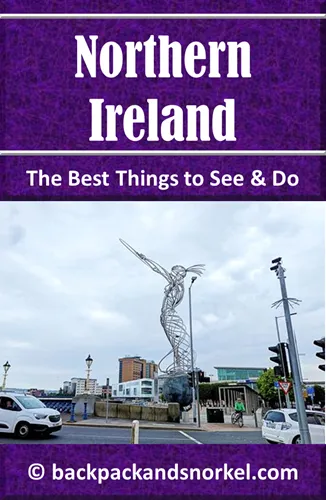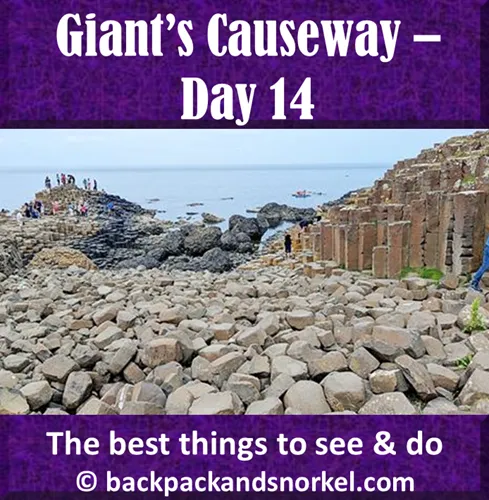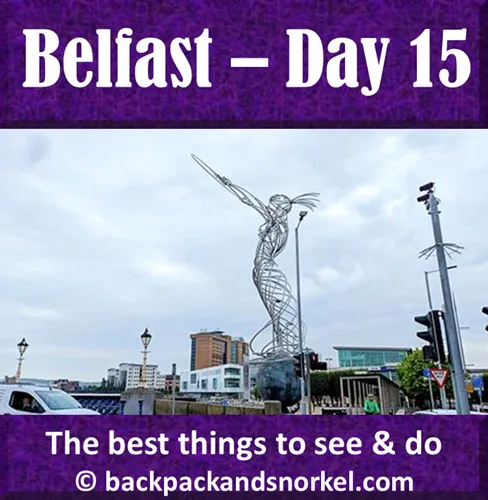Backpack and Snorkel Travel Guide for a Self-Guided Belfast Tour - Northern Ireland Purple Travel Guide
Today is our last day in Belfast. We will see the iconic Titanic Museum, the Crumlin Road Gaol, the Bobby Sands Mural, and the relaxing Botanic Gardens. We provide detailed information and the best things to see and we show lots of photos so you know what you can expect.
We will start the day with a visit of the iconic Titanic Museum, then we will visit the Crumlin Road Gaol and Bobby Sands Mural which are important sites regarding The Troubles, and we will finish our Belfast tour at the relaxing Botanic Gardens before we drive to Dublin and fly back home tomorrow.

1 = Titanic Belfast
2 = Crumlin Road Gaol
3 = Bobby Sands Mural
4 = Botanic Gardens
Here at Backpack and Snorkel Travel Guides, we typically promote self-guided walking tours.
But we realize that not everybody likes to walk by themselves in a foreign city. So, just in case that you rather go with ab guide: NO PROBLEM! Please see the free GuruWalk and paid Viator tours below.
free GuruWalk tours
paid Viator tours
Titanic Belfast
The Titanic Belfast museum is located on the site of the former Harland & Wolff shipyard where the RMS Titanic was built.
It was opened in 2012, one hundred years after the RMS Titanic held its maiden voyage, hit an iceberg, and sank.
The museum building is 126 ft (38 m) tall (same height as the Titanic’s hull) and much of its façade is covered with 3,000 silver-anodized aluminum panels.
The interior of the eight-story building has 130,000 sqft (12000 m2) of exhibition and meeting space.
A reproduction of the iconic staircase that was popularized by the 1997 James Cameron film Titanic is located on the top floor – it is a reimagined staircase as there are no original drawings.
The lower floors have galleries that tell these stories:
- Boomtown Belfast – the city at the start of the 20th century
- The Shipyard – a ride aboard a mini-car up and around a replica of Titanic's rudder
- The Launch – how Titanic was launched on 31 May 1911
- The Fit-Out – the fitting-out of Titanic from her launch through to April 1912
- The Maiden Voyage – the journey from Belfast to Southampton, and from there to Cherbourg, Cobh and westwards
- The Sinking – the disaster of 14/15 April 1912
- Never Again – the chain reaction of events which caused Titanic to sink and the measures put in place to prevent a tragedy like this from happening again
- Ballard’s Quest – the period of years when the ship was missing
- The Ship of Dreams – go on a reflective journey of the hopes and dreams of those impacted by the famous ship
- The Lasting Legacy – see how the significance of the Titanic story has impacted Belfast and captured the world’s imagination through film, theater, and literature
Opening times vary by month – please see their website for current opening times.
At the time of writing, admission is £24.95 per adult – discounted tickets are available for kids, seniors, students, and families. Guided tours are available for an extra charge.
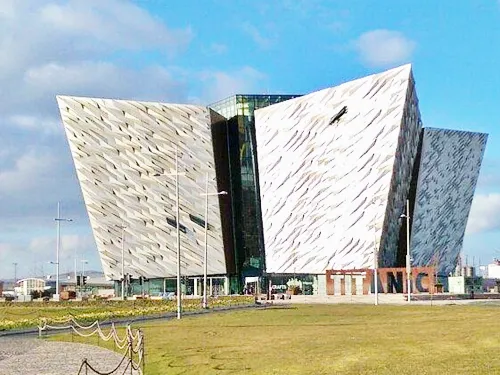



Crumlin Road Gaol
Crumlin Road Gaol (gaol = jail), also known as HM Prison Belfast, The Crum, or Europe's Alcatraz, is a former prison on Crumlin Road.
The gaol was built from 1843 - 1845 and closed in 1996 and then sat empty until it was restored, and opened as a tourist attraction, conference center, concerts event space in 2012.
Queen Elizabeth II visited the goal in 2014.
When it was built, Crumlin Road Gaol was one of the most advanced prisons of its day – it separated prisoners in their individual cells from each preventing any communication between them.
Enclosed by a five-sided wall, it consisted of a central building (The Circle) with four wings that are up to four stories tall. In the early 1970s, sometimes up to three prisoners were placed in cells that were designed for only one 12 × 7 ft, (3.7 m x 2.1 m). In 1971 the International Red Cross found 864 prisoners in 475 cells.
The original prison did not contain a space for executions and thus, they were carried out in public view until 1901. Afterwards, an execution chamber was built. The 17th and last hanging occurred in 1961. The bodies of most executed were buried inside the prison in unconsecrated ground, against the back wall beside the prison hospital.
At the time of writing, opening hours are:
Opening time : 10am
Apr – Aug: Sun – Thu: Last admission: 4pm
Apr – Aug: Fri & Sat: Last admission: 4:30pm
Sep – Mar: Sun – Sat: Last admission 4pm
Admission is £14.50 per adult (£0.50 discount if booked online) – discounted tickets are available for kids, seniors, students, and families.

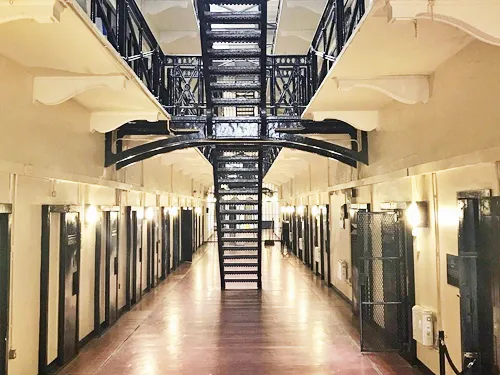
Bobby Sands Mural
Robert Gerard Sands (1954 –1981) was a Northern Ireland catholic whose family and himself had been discriminated and mistreated by protestants for much of his life – just for being catholic.
He became a member of the Provisional Irish Republican Army (IRA), and helped to plan the 1976 Balmoral Furniture Company bombing in Dunmurry. There was a gun battle with the Royal Ulster Constabulary afterwards and Sands and his fellow attackers were arrested while trying to escape. He was sentenced to 14 years for firearms possession.
Bobby Sands was incarcerated at Crumlin Road Gaol and mistreated. The UK government then changed the status of political prisoners to ordinary criminals.
On March 1, 1981, Sands started his hunger strike and others joined in.
The hunger strike was about these five demands:
- the right not to wear a prison uniform
- the right not to do prison work
- the right of free association with other prisoners, and to organize educational and recreational pursuits
- the right to one visit, one letter, and one parcel per week
- full restoration of remission lost through the protest
During his hunger strike, Sands was elected to the British Parliament as an Anti H-Block candidate. He was never able to take his seat in the British parliament, as he died a few months later. The British parliament then introduced a law preventing prisoners serving jail terms of more than one year from being nominated as candidates in British elections.
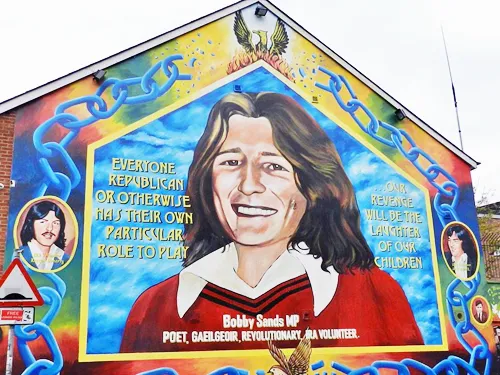
Botanic Gardens
The 28-acre (11 ha) Belfast Botanic Gardens opened in 1828 as the privately owned Royal Belfast Botanical Gardens. Until 1895, when it became a public park, the gardens were only open to the public on Sundays.
The most well-known park feature is the Palm House conservatory, which was built in 1839/1840, and is one of the earliest examples of curvilinear cast iron glasshouses in the world.
The park has a large multi-use lawn that is used for concerts, and music festivals.
At the time of writing, the park opens at 7:30am every day, and closes between 4:30pm and 10pm, depending on the month.
Admission is free.
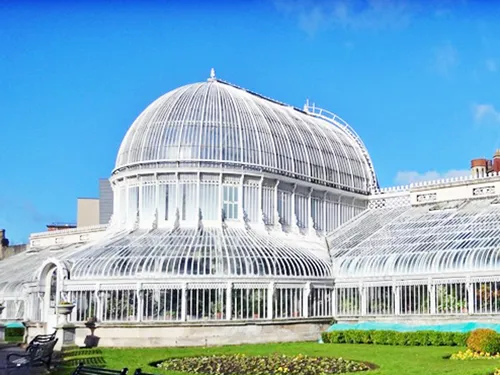



Where do you want to go now?
Author: Rudy at Backpack and Snorkel
Bio: Owner of Backpack and Snorkel Travel Guides. We create in-depth guides to help you plan unforgettable vacations around the world.
Other popular Purple Travel Guides you may be interested in:
Like this Backpack and Snorkel Purple Travel Guide? Pin these for later:


